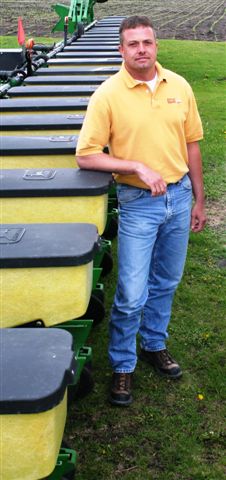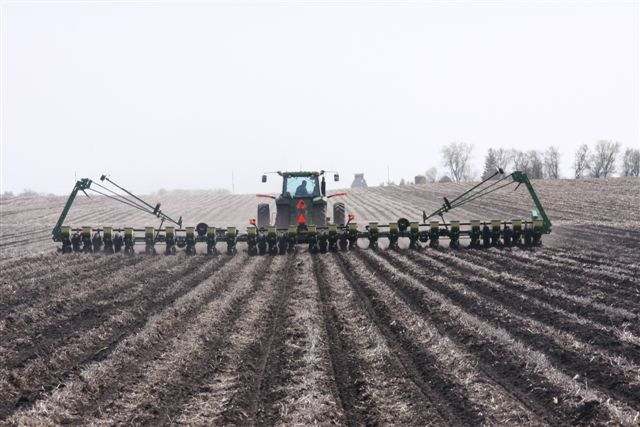Trying strip-till on a small scale, using auto-steer when strip-tilling and taking advantage of cost-sharing programs are some of the ways prospective and current strip-tillers can improve their bottom line, says Dave Nelson, a Ft. Dodge, Iowa, strip-tiller.
 Dave Nelson |
Nelson, who co-owns Brokaw Supply with his father, sells strip-till, fertilizer and precision ag equipment. Here are Nelson’s seven recommendations to make more money strip-tilling.
1. Start Small
Try strip-till on 40 or 80 acres first instead of on all your acres and learn how to make it work for you. Do this instead of investing $50,000 or $100,000 in equipment right off the bat. Learning on a small scale limits risk.
“If you are first trying it, you will be able to tweak it,” Nelson says. “This will also give you a chance to communicate with your landlords to make sure they are on board because there’s a very visible difference in conventionally tilled and strip-tilled fields.”
2. Strip In Bean Stubble First
Start out by strip-tilling in soybean stubble because it’s easier to manage than strip-tilling continuous corn. If you are trying to strip-till continuous corn, about 75% of the field will be covered with residue.
You need to have some strip-tilling experience before you start strip-tilling corn on corn, Nelson says.
3. Focus On Savings First
Don’t expect yield increases right away from strip-tilling. Look at that savings in fuel, labor and machinery if switching from conventionally-tilled corn.
“Everything is about net income,” Nelson says. “We’re saving $20 to $30 per acre in fuel, labor and machinery by using strip-till in our farming operation. We are in our third year strip-tilling and we are just now seeing increased yields.
“The sides by sides that we’ve done next to conventional tillage prove to us that strip-tillage gives comparable-to-increased yields.”
4. Don’t Skimp On Fertilizer
Don’t look at strip-till as a way to save on fertilizer.
“You can only steal from the soil’s nutrient bank account for so long before it’s empty,” Nelson says. “A bushel of corn is a bushel of corn and it takes so many units of fertilizer to grow it no matter how the fertilizer is applied.
“The point about strip-till is that your crops are better utilizing nutrients because the seeds are planted into the strip with the fertilizer.”
5. Use Auto-Steer
Auto-steer will make you a better strip-tiller, Nelson says. It allows you to look at the equipment and see if you need to adjust a residue manager, coulters or a sealer.
Auto-steer makes the strips straight. Auto-steer on your planter isn’t a necessity if you have flat ground, but on hills and contours, auto-steer on the planter makes sense.
6. Find Cost-Share Money
Check with the USDA’s Natural Resources Conservation Service, as well as state commodity groups, to see what money may be available for trying and/or buying strip-till equipment. The Conservation Stewardship Program (CSP) provides cost share for the adoption of strip-till.
Also, check to see if your watersheds are in the Upper Mississippi River Basin Initiative (UMRBI) or other USDA priority watersheds. There’s a lot of money available if you are in a specific watershed in the MRBI.
7. Strip-Till Soybeans
While many strip-tillers start with soybean ground ahead of corn, consider strip-tilling in cornstalks ahead of soybeans, too.
“Last fall, we strip-tilled into cornstalks that we planted to soybeans this spring. It made beautiful strips,” Nelson says. “Our strip-till unit cleared away the trash. All of the fluff fell back onto the strips, but by this spring, with the help of residue managers on the planter, we had clean strips and black soil to plant into.
“About 95% of the soybeans in the Ft. Dodge area are planted into conventionally tilled fields. We want to work our way to no-tilling soybeans into cornstalks. With strip-tilling corn stalks and then planting soybeans, I’m planting them into pure black, warm, moist soil, just like Mom’s garden!
|
Iowa strip-tiller Dave Nelson plants into a strip-tilled field. |
"By strip-tilling, I’m penetrating the upper hardpan that’s 6 to 7 inches below the surface. And by strip-tilling soybeans, we are halfway to no-till and we are still eligible for CSP cost-share.”
The Nelsons use a Blu-Jet 12R30 Landrunner strip-till rig equipped with Yetter Magnum residue managers. They pull a Montag fertilizer cart behind the toolbar. They helped design and build the first split-fertilizer bin that Montag now manufactures. The Nelsons use variable-rate application for anhydrous ammonia protected by N-Serve, potash and also phosphate.
“Strip-tillers are always looking to change and try something different and they want to know what other strip-tillers are making work," Nelson says.
“The regular, common farmer just wants to go to customer appreciation days, demo new big tractors and keep up with the Joneses. We are looking to start a strip-tillers’ roundtable and peer group. We've had a lot of requests for this from our growers.”






